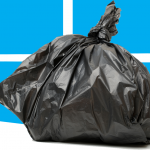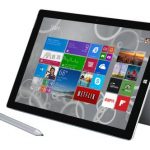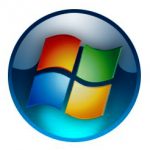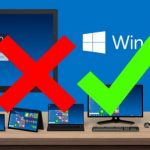Windows 8.1's market share remains utter rubbish

Last month, web analytics firm NetMarketShare released its usual batch of monthly desktop operating system usage share figures, and it showed Windows 8.x tumbling dramatically. The figure made little sense, and a day later the firm released revised data which showed the tiled OS still shedding a large chunk of share, but not quite as badly.
In December’s revised figures NetMarketShare had the OS falling 5.13 percentage points for a total share of 13.52 percent, placing it back way below Windows XP. This meant January’s figures were always going to be interesting. Surely the tiled OS would rally wouldn’t it? But of course this is Windows 8.x, Microsoft’s least successful operating system in recent memory, so no. Its usage share remains utterly rubbish.
Microsoft's decision to ditch Surface is a long-overdue mercy killing for Windows RT

For too long it was the metaphorical unwanted litter of kittens tied in a sack just waiting for someone to ditch it in the river. Windows RT is dead, having enjoyed a cancer-ridden 'life' for longer than many people expected. Microsoft announced that it is no longer going to manufacture Surface devices, all but signing the death warrant for Windows RT.
Hear that sound? No? That's the sound of everyone caring about it. To be fair, the writing has been on the wall for quite some time. Windows RT was always the sickly twin sibling of Windows 8 and now Microsoft has done the decent thing. It might not quite have delivered the lethal shot to the brain yet, but the gun has been cocked. And not before time.
Windows 10 Technical Preview Build 9926 hands on -- making good on earlier promises

Windows 10 has been something of a tease so far. There have been hints that it could be a good operating system, protestations that it will be great, but a series of preview builds that have been a little uninspiring. With the release of build 9926, it appears that Microsoft is starting to deliver on its promises. From this release we can see that Windows 10 is actually starting to take shape.
Microsoft is clearly pleased with the progress that has been made because it has simplified the process of upgrading from Windows 7 and Windows 8 -- Windows Update can be used to install the Technical Preview. It might not quite be ready for prime time just yet, but I'm cautiously optimistic even though I've been far from impressed with previous builds. Oh, and before you ask, there's no sign of Spartan just yet. So… what's new and what's improved? Let's take a look.
Google reveals two more unpatched Windows security bugs

Earlier in the week, Google managed to raise the ire of Microsoft by publishing details of a vulnerability in Windows before a patch had been published. Now the same thing has happened again, but this time it's a double whammy. Google Security Research has revealed two more security holes that Microsoft is yet to fix.
Just as was the case a few days ago, Microsoft had been warned about the security problems and Google agreed to keep details private for a period of 90 days. Now the three months is up, details of the security issues have been automatically published, running the risk that users could be targeted.
NetMarketShare adjusts its figures -- still has Windows 8.x losing major usage share

Yesterday, web analytics firm NetMarketShare released its monthly breakdown of desktop operating system usage share, and it contained a huge shock. According to the figures, Windows 8.x had dropped to its lowest usage share since March 2014, putting it back below XP.
It was a surprise because Windows 8 and 8.1 had both shown solid growth in the previous two months, but suddenly, according to NetMarketShare, 8.x had dropped a whopping 7.07 percentage points in a single month, most of that going to Windows NT. As I observed when reporting, something not quite right there. Late yesterday, the figures were pulled, and new ones have appeared today that show the tiled OS still doing badly, just not quite as badly.
Windows 8.x is no longer a huge embarrassment to Microsoft

Last month Windows 8.x's usage share did something very surprising -- it went up. Massively, according to figures from web analytics firm NetMarketShare. The tiled OS had been losing share for months, but in October it suddenly took off like a rocket, packing on 4.54 percentage points share in a single month, mostly at the expense of Windows XP.
It wouldn’t have been a total surprise to see Windows 8.x's growth stop, or go back into reverse gear in November, but actually, both Windows 8 and 8.1 showed positive gains once again.
Windows 8.1 finally takes off -- shows staggering market share growth

Hands up if you saw that coming? We’ve been so used to Windows 8 and 8.1 losing usage share month on month, that any kind of move in the right direction -- i.e. growth -- seems almost an anomaly. And when Windows 8.x does gain usage share, it’s usually pretty minimal.
Not in October. According to the latest usage share figures from web analytics firm NetMarketShare, Windows 8 use grew in that month, and Windows 8.1 (finally) took off like a rocket. In fact, Windows 8.1’s growth in that month is so impressive you’ve got to imagine the number crunchers at NetMarketShare spent a long time checking and re-checking their findings to make sure there wasn’t a mistake at their end.
Surface generated almost $1 billion revenue for Microsoft last quarter

Anyone who was under the impression that Surface was a failure for Microsoft need look no further than the latest earnings release for proof that they're wrong. In the quarter ending September 30, Microsoft pulled in $23.20 billion in revenue, and $908 million of this came from the Surface division.
All told, FY15 Q1 represents record first quarter revenue for Microsoft, and it can be at least partly attributed to the influence of Satya Nadella, as well as the restructuring surrounding Nokia Devices and Services. There was a strong performance in the Devices and Consumer divisions, with revenue increasing 47% to $10.96 billion, while commercial revenue rose 10% to $12.28 billion.
Forget Mighty Mouse... forget Mickey Mouse... meet Music Mouse! [Review]
![Forget Mighty Mouse... forget Mickey Mouse... meet Music Mouse! [Review]](https://betanews.com/wp-content/uploads/2014/10/music_mouse-150x150.jpg)
Sometimes a device that does a single job just doesn’t cut the mustard. See those speakers cluttering up valued space on your desk? Be gone foul cones; your services are required no more! Are we foregoing music? Not a bit of it! We are switching to a wireless mouse with an integrated Bluetooth speaker! At least we are if it turns out to be any good...
Things don’t get off to a great start. The Seenda IBT-C04 Music Mouse looks reasonable enough, if slightly retro; but in the hand it's big and angular. There is a slight nod to ergonomics and even a slightly rubberized grip area where your thumb falls, but from the offset it's not comfortable. Perhaps the minor discomfort is made up for by the extra features.
The best free Start menus for Windows 8.1

With Windows 10, Microsoft will finally restore the missing Start menu to its tiled operating system. That’s great news for anyone who isn’t a fan of the Start screen and Modern UI. But Windows 10 is still a good six months away (probably longer), so until it arrives, the only options for users of Windows 8.x is to either accept the Start screen, or install a third party Start button and menu.
The good news is there are plenty of excellent free options available. Here are our top 12 recommendations.
The curmudgeon's guide to Microsoft's embryonic Windows 10

It's only a matter of days since Microsoft officially revealed the Windows 10 Technical Preview. This was a revelation with a lot riding on it but it was really something of a tease -- Microsoft didn’t give too much away. We rushed to grab the download, and Wayne showed how to get it up and running in VirtualBox (interestingly, I had to opt for VMware Player, as VirtualBox refused to install the 64-bit version of Windows 10 on my Surface Pro. It ran away from the ISO as though it was infected with ebola). I've had a few days to play about with this release -- I've stuck with a virtual machine for now rather than going all-in with dual-boot -- and I've already had a chance to write a little about the Start menu and the command prompt, but now it's time to delve a little deeper and see what else there is to discover.
Spoiler alert: despite the headline, and indeed my reputation, I don’t hate Windows 10. It just about goes without saying that I'm not head-over-heels in love with it, and there's a great deal I dislike about it, but it does feel... well, just 'nice' really. It's comfortable, familiar, and feels a bit snappier than Windows 8 -- even when running in a virtual machine.
Windows 8.x goes back into reverse gear, losing the most usage share yet

Windows 10 really can’t come soon enough for Microsoft as its predecessor is continuing to tank. In August the tiled OS actually gained usage share -- according to web analytics firm NetMarketShare -- which was unusual as 8.x had lost users in the previous two months. But any suggestions of a recovery are swiftly crushed looking at September’s figures. Both Windows 8 and 8.x lost a load of usage share last month, while Windows 7 reached an all-time high. It’s Windows 7 users Microsoft really needs to be aiming for with Windows 10 (and if it can tempt XP users too, so much the better). In August, Windows 8 managed a 6.28 percent share of the desktop operating system market, but lost 0.69 percent in September. Windows 8.1, an OS which really should be growing, went from an all-time high of 7.09 percent to 6.67 percent, a drop of 0.42 percent. In total, Windows 8.x lost 1.11 percent share. Windows 7 on the other hand went from 51.21 percent in August to 52.71 percent in September, a gain of 1.5 percent. That’s its highest point ever. Windows XP, which should be losing share, dropped just 0.02 percent, going from 23.89 percent to 23.87 percent. So September was another dreadful month for Windows 8.x. It’s no wonder Microsoft decided to skip ahead to Windows 10 in an attempt to really distance its future OS from the current one.
// Photo Credit: i3alda/Shutterstock
Chromebooks are in trouble -- HP unveils $199 Windows laptop and low-cost tablets

When I bought my first Chromebook, the 2012 Samsung model, I did it mostly for one reason -- price. I drove down to my local Best Buy and was blown away by how inexpensive it was; at $249 it looked like a MacBook Air and promised good battery life. Even though I knew the limitations of Chrome OS beforehand, I still handed over my money thinking I could find a place for it in my home. For the most part it was OK; I mean, it changed the way I thought about computing, but it soon became apparent that it could not replace my Windows machine. I didn't return it; I kept for basic typing on the go, but I later sold it as it collected dust. You see, my iPad Air when coupled with a keyboard-case was a better portable machine.
Now, in 2014, Chromebooks are making huge strides in homes, schools and the enterprise, but Windows still reigns supreme. While I do recommend Chromebooks for people low on cash that only have basic computing needs, today this changes. You see, HP announces the $199.99 Stream 11 laptop, and with a price that low, why would you bother with Chrome OS?
Migrating from Windows Server 2003: 12 best practices straight from the trenches

Most of us have hopefully managed to get off the sinking ship that was Windows XP. As much of a recent memory as that has become, a new end of life is rearing its head, and it's approaching fervently for those who haven't started planning for it. Microsoft's Windows Server 2003, a solid server operating system that's now about eleven and a half years old, is heading for complete extinction in just under 300 days. Microsoft has a fashionable countdown timer already ticking.
Seeing as we just finished our second server migration in a single week (a personal record so far), sharing some of the finer aspects of how we are streamlining these transitions seems like a timely fit. This braindump of sorts is a collection of best practices that we are routinely following for our own customers, and they seem to be serving us well so far.
Windows 8.x gains usage share at the expense of Windows XP

New data which was just posted by web analytics company NetMarketShare shows us that, in August, Windows 8.x managed to gain precious usage share in the desktop operating system market. This happened mainly at the expense of the 13 year-old Windows XP, which is seeing its usage share slowly decrease as new devices, toting newer OSs, are brought into the fold.
The good news, however, comes from the rise in usage share of Windows 8.1, which is now at 7.09 percent, up from the 6.56 percent from July. Windows 8 also grew, to 6.28 percent from 5.92 percent, but this is of a lesser importance, as its successor's fate is far more important. Meanwhile, Windows XP decreased to 23.89 percent from 24.82 percent. Still, it is obvious that the oldest of the three still has a terribly long way to go before it reaches similar usage share levels (we're looking at a couple of years, at least) as Windows 8.1 touts now.
Recent Headlines
Most Commented Stories
BetaNews, your source for breaking tech news, reviews, and in-depth reporting since 1998.
© 1998-2025 BetaNews, Inc. All Rights Reserved. About Us - Privacy Policy - Cookie Policy - Sitemap.